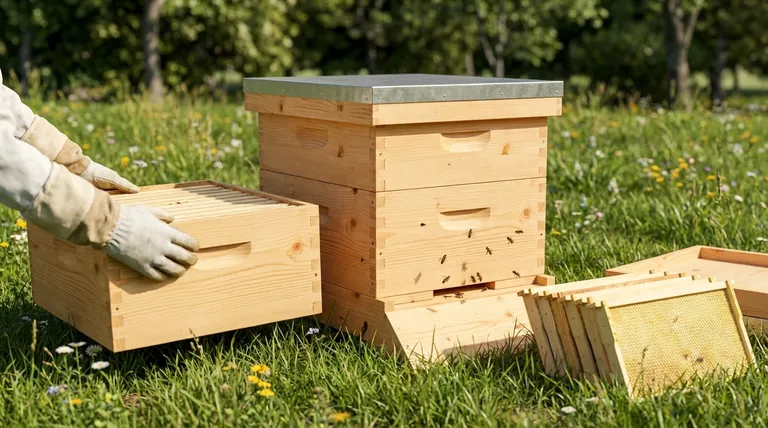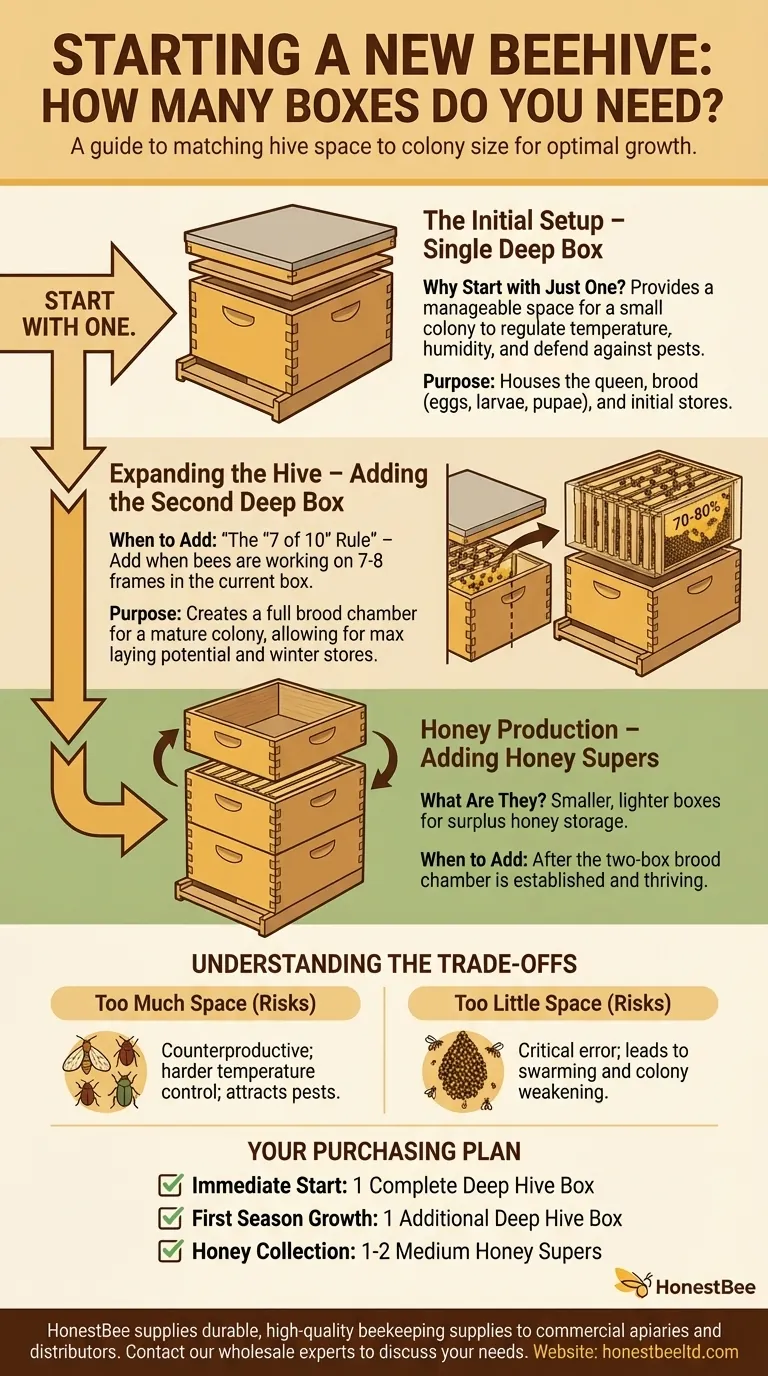To start a new beehive, you will begin with a single deep hive box. This initial box serves as the foundation for the colony, providing a manageable space for the new queen and bees to establish their brood nest. You will add more boxes only as the colony grows and requires more room.
The core principle is to match the hive space to the colony's size. You start with one box to prevent overwhelming a small colony, but you must have a second brood box and honey supers ready to add as the bees expand.

The Initial Setup: The Single Brood Box
Your first step is to establish the core of the hive, known as the brood chamber. This is where the queen lays her eggs and the colony raises new bees.
Why Start with Just One?
A new bee package or nuc is a relatively small population. Giving them a single box provides a confined, manageable space.
This allows the small colony to more easily regulate the internal temperature and humidity, which is critical for raising brood. It also makes the hive easier for them to defend against pests.
The Purpose of the First Box
This first deep box is exclusively for the bees. It will house the queen, the brood (eggs, larvae, and pupae), and the initial stores of pollen and nectar the colony needs to survive and grow.
Expanding the Hive: When to Add More Boxes
The most common mistake for new beekeepers is not adding the next box in time. A crowded colony is a colony preparing to swarm, which means you could lose your queen and half your bees.
The "7 of 10" Rule
A reliable indicator for adding the next box is the "7 of 10" rule. Once the bees have drawn out comb and are actively working on seven or eight of the ten frames in their current box, it's time to add another one on top.
Creating the Full Brood Chamber
For most climates and beekeeping styles, the standard goal is a two-box brood chamber. This second deep box gives a mature colony the necessary space for the queen to reach her full laying potential and for the workers to store enough honey and pollen to survive the winter.
Adding Honey Supers
Once your two-box brood chamber is established and thriving, any additional boxes you add are called honey supers. These are placed on top of the brood chamber, and their purpose is to store surplus honey that you can harvest.
Honey supers are often medium or shallow boxes, which are lighter and easier to lift than the deep brood boxes when full of honey.
Understanding the Trade-offs
Managing hive space is a balancing act. Both too much and too little space can create significant problems for the colony.
The Risk of Too Much Space
Giving a new colony two deep boxes right away can be counterproductive. The bees may struggle to control the temperature of such a large area, and the vast, undefended space can attract pests like wax moths or small hive beetles.
The Risk of Too Little Space
Waiting too long to add a second box is a critical error. When bees feel crowded, they activate their natural instinct to reproduce by swarming. The old queen will leave with a large portion of the bees to find a new home, severely weakening your hive.
Your Hive Box Purchasing Plan
Thinking about your needs for the entire first season, not just day one, is the key to success.
- For your immediate start: You need one complete deep hive box (bottom board, deep box with frames, inner cover, and outer cover).
- For the first season's growth: You need a second deep hive box ready to be added once the first is nearly full.
- For potential honey collection: You should have at least one or two medium honey supers on hand in case you experience a strong nectar flow.
By starting small and adding space in response to your colony's growth, you provide the ideal environment for your bees to thrive.
Summary Table:
| Hive Box Type | Purpose | When to Add |
|---|---|---|
| First Deep Box | Brood chamber for new colony | Initial setup |
| Second Deep Box | Full brood chamber for a mature colony | When 7 of 10 frames in the first box are full |
| Honey Super(s) | Storage for surplus honey | After the two-box brood chamber is established |
Ready to build a thriving hive?
Starting with the right equipment is the first step to beekeeping success. HONESTBEE supplies durable, high-quality beekeeping supplies and equipment to commercial apiaries and beekeeping equipment distributors. We understand the precise needs of a growing colony, from the initial deep box to the honey supers.
Let us equip your operation for a productive season. Contact our wholesale experts today to discuss your needs.
Visual Guide

Related Products
- Australian Langstroth Beehive Boxes for Beekeeping Wholesales
- Langstroth Bee Hives Bee Keeping Box for Beginners Beekeeping
- Langstroth Honey Bee Box Hive Boxes for Different Depths
- HONESTBEE Professional Long Handled Hive Tool with Precision Cutting Blade
- Professional Insulated Plastic Bee Hives
People Also Ask
- What color should beehives be painted? The Best Choice for Hive Health and Honey Production
- What are the sizes of supers available in a standard hive? A Guide to Deep, Medium, and Shallow Boxes
- What is the purpose of reversing brood chambers in the spring? A Proactive Swarm Prevention Strategy
- How many frames fit into a standard beehive box? Choose Between 8-Frame and 10-Frame Hives
- What are beehive boxes, and what are they used for? The Essential Guide to Hive Components



















